Banana Cultivation: Take special care of these things while cultivating banana, you will become rich in the very first season
Banana Cultivation: If you are also considering growing bananas, then this information can be very helpful for you. Yes, we are talking about keeping the plants at the maximum distance from each other while cultivating bananas. This distance not only keeps the plants healthy but also improves the quality and yield of the crop. According to Sanjay Kumar Singh, a scientist at Dr. Rajendra Prasad Central Agricultural University, Pusa, the distance between plants should be chosen based on cultivation technique, soil texture, variety and environment.

For dwarf varieties like Grand Nain, etc., a distance of 1.5 m x 1.5 m (about 4444 plants per hectare) is considered suitable, while for tall varieties like Malbhog, a distance of 1.8 m x 1.8 m (about 3200 plants per hectare) is better. If farmers are doing mixed farming, then the plants should be planted at a distance of 3.6 meters. Keeping adequate distance between the plants ensures adequate light and air circulation, which also reduces the incidence of pests and diseases.
It is very important to have a scientific understanding of land, climate and soil
The tropical fruit banana thrives in temperatures between 15 and 35 degrees Celsius. Choose sites that are free from frost or strong winds and receive full sunshine. It can be cultivated on flat or gently sloping land with adequate drainage. Bananas thrive in loamy soil, as it retains moisture well and does not have waterlogging problems. The ideal range for soil pH is 6.0 to 7.5. If the soil is too acidic or alkaline, use remedial treatments such as gypsum or lime. Field cleaning, vigorous tillage and soil preparation with organic manure strengthen the production base.
Plant selection and planting technique
Properly sized pits should be dug before planting. Pits 45 cm wide or 60 cm deep are often dug at a distance of 1.5 x 1.5 m or 2 x 2 m. These pits should be kept open for 15 days to get sunlight to kill dangerous insects and bacteria. After filling the pits with a mixture of rotten farmyard manure, Furadan, neem cake and dug-out soil, light watering should be done. Plant only certified, disease-free and healthy plants; if possible, use tissue-cultured plants. Putting organic mulch around the plants helps them retain moisture and keep weeds away.
It is very important to avoid waterlogging
Avoiding waterlogging is extremely important while cultivating bananas. To save water and retain moisture, ensure that the field has adequate drainage, and if possible, use a drip irrigation system. Organic manure, balanced nutrient management and selection of fertilizers based on soil testing increase production. Farmers can grow crops like marigold, cauliflower, radish and turmeric in the fallow fields during the first four months of cultivation to increase their income. It is important to remember that planting cucurbits can cause viral diseases to develop in banana plants. Bananas not only increase agricultural yield but also help farmers become economically self-reliant if scientific agricultural practices are used.

